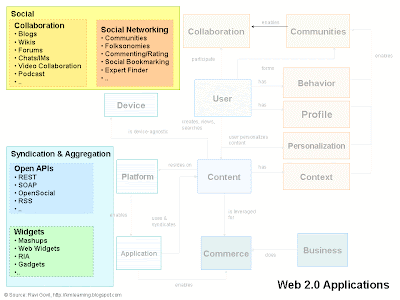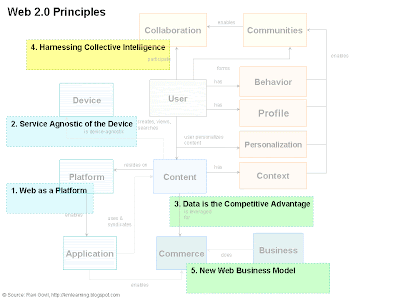In my previous post, I had demonstrated the conceptual model of web 2.0 that shows all objects and their relations. It is high level visual representation of web 2.0 object graph. In continuing with the concept, I am trying to map these objects with web 2.0 principles and technologies in this post.
The key principles of web 2.0 are:
1. Web as a Platform - It is a large single market place with over a billion people using it. It is primary global store for the software and data. Over last few years more and more product and services are getting integrated and available on the web. The web grew at the same rate as the technology advances in network bandwidth over the period of time. The higher network has become faster and cheaper, has been widely adopted during this period. Now more and more software are available on the web as services and are getting integrated with main stream applications.
2. Services Agnostic of the Device - In web 2.0 era, the applications and content are designed to be delivered across devices so that it can be accessed from anywhere, anytime. More so now the content and services resides in the cloud. In web 2.0, device does not constraint the services but embraces it.
3. Data is the Competitive Advantage - Organizations are leveraging the data and content for creating new business models. Now not just the software but also data is great market asset. "Data is the the new intel inside". Companies like Google, Youtube, Linkedin leveraging the data to create new innovated services and business models on the web.
4. Harnessing Collective Intelligence - Next generation application are now more user centric rather process centric. End user is no longer just a consumer but also a partner, empowering them to improve the products and services. The focus has been shifting from command and control enterprise culture towards collaboration and teamwork. The end users create the network effect.
5. New Web Business Model - Web 2.0 advocates opening your platforms to others, integrating other applications to bring more value to en users and business.
Other than those mentioned above, there are additional principles which are more pertinent toward delivery and user experience. Though these existed in web 1.0 era but were not that important and were not major constraints to the apps. For instance..
1. Rich User Experience
2. Continuous and Incremental Releases
Now I will classify the web 2.0 technologies with respect to the conceptual model, where and how these technologies fit together.
1. Social - The social apps can further be classified into collaboration and social networking. Some of the collaboration applications are blogs, wikis, forums, chat, podcast etc. Some of the social networking applications are social apps, folksonomy, social bookmarking. Though I have seen lately these applications are merging into a single platform.
2. Syndication and Aggregation - Some of the apps in this category are RSS, REST, OpenSocial, mashups, web widegts, RIA, gadgets.
Please let me know your comments about the web 2.0 conceptual model and its mapping with principles and technologies.
Additional Links
1. Web 2.0 - Conceptual Model
Friday, May 16, 2008
Web 2.0 - Conceptual Model (Part 2)
Labels:
blogs,
Collaboration,
Communities,
Enterprise 2.0,
Web 2.0,
wikis
Subscribe to:
Post Comments (Atom)


6 comments:
Great stuff!! I'll come back again.
Great blog! Nice template Directory submitted
Nice blog! Add
Great article! web template
Your blog is so helpful for me because I found job openings in knowledge management from last week. Thank you for sharing this information.
Thanks for sharing content and such nice information for me. I hope you will share some more content about. Web 20 conceptual please keeps sharing!
Asset Management System
Post a Comment